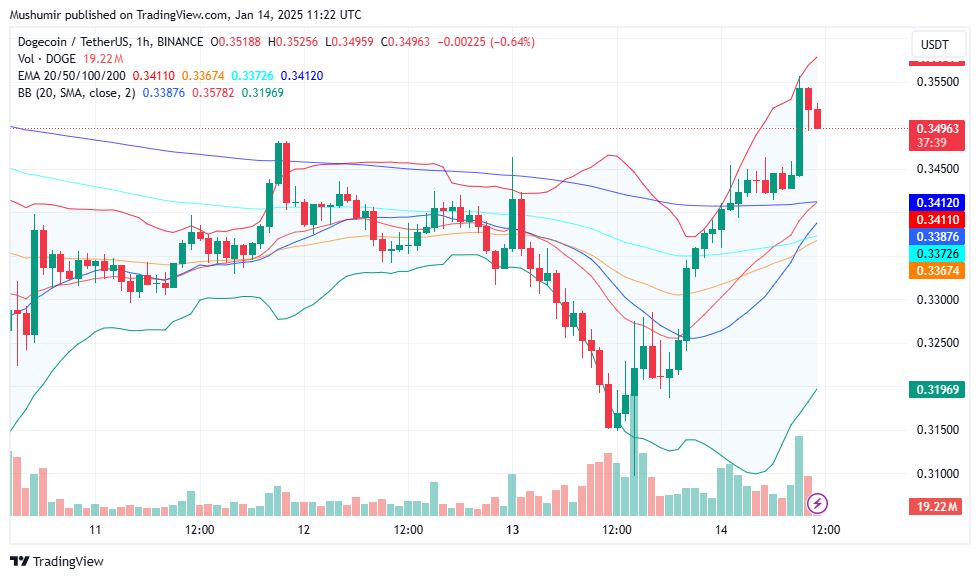
Dogecoin (DOGE) is currently trading at $0.3516, showing a slight uptick of 0.10% from yesterday. In today’s session, the price range has been between $0.3128 and $0.3555, giving us a glimpse of its intraday volatility.
While it’s been a bit of a bumpy ride recently, with the token losing around 4.94% over the past week and 7.09% in the last month, the bigger picture tells a more optimistic story. Compared to the same time last year, DOGE is still up an impressive 124.07%, which is a testament to its long-term potential despite short-term fluctuations.
Dogecoin Price Analysis

From a technical standpoint, the Relative Strength Index (RSI) is sitting comfortably at 48.47, which places it right in the neutral zone. This means DOGE isn’t showing signs of being overbought or oversold at the moment. Meanwhile, the Moving Average Convergence Divergence (MACD) is slightly negative at -0.01, hinting at a mildly bearish sentiment in the short term.
The Average Directional Index (ADX) comes in at 21.70, suggesting that the current trend isn’t particularly strong. Essentially, the market seems to be in a bit of a holding pattern for now. The moving averages provide some interesting insights. The 10-day simple moving average (SMA) is around $0.34, while the 20-day SMA is hovering at $0.35. With the current price just above these levels, it’s a bit of a tipping point that could go either way.
Traders often use these points to gauge momentum, and a clear break in either direction might signal the next big move. Support and resistance levels also come into play here. DOGE seems to have solid support in the low $0.30 range, which has held firm through recent dips. However, resistance around $0.36 continues to be a tough barrier to cross.
Should it manage to break above this resistance, we could see some bullish momentum kick in. On the flip side, if it falls below the current support, the price might retreat to the high $0.20s. Right now, Dogecoin seems to be in a consolidation phase, which isn’t unusual for a token that thrives on market sentiment and community-driven momentum.
This quiet period could be the precursor to its next big move, whether that’s an upward breakout or further retracement. For short-term traders, keeping an eye on volume spikes and sentiment shifts could provide clues on timing. Long-term holders, on the other hand, might find comfort in the token’s historical ability to rebound and surprise the market. It’s all about patience and watching for those key signals to unfold.
Dogecoin Price Prediction
Predicting Dogecoin’s exact price involves analyzing various factors, including market sentiment, technological developments, and macroeconomic conditions. Analysts anticipate that Dogecoin may trade between $0.27 and $0.32 in January 2025, depending on market dynamics.
Some experts are more optimistic, suggesting that Dogecoin could reach $1.33 by 2025 if certain market conditions are met. However, these Dogecoin price predictions should be approached with caution, as the cryptocurrency market is highly volatile and influenced by numerous unpredictable factors.
Frequently Asked Questions (FAQs)
Is Dogecoin a good investment?
Investment decisions should be based on individual risk tolerance, investment goals, and thorough research. Consulting with a financial advisor is recommended before making investment choices.
How does Dogecoin compare to other cryptocurrencies?
Dogecoin is often compared to other digital assets like Bitcoin and Ethereum. While Bitcoin is primarily a store of value and Ethereum offers a platform for decentralized applications, Dogecoin started as a meme coin but has gained traction for its active community and low transaction fees.
What are the risks associated with investing in Dogecoin?
Risks include market volatility, regulatory uncertainties, technological challenges, and the speculative nature of cryptocurrencies.
Investment Risk Consideration
Investing in cryptocurrencies like Dogecoin carries inherent risks due to their volatile nature. It’s essential to conduct comprehensive research, assess your financial situation, and consider your risk tolerance before investing. Diversifying your investment portfolio and consulting with financial professionals can help mitigate potential risks.









